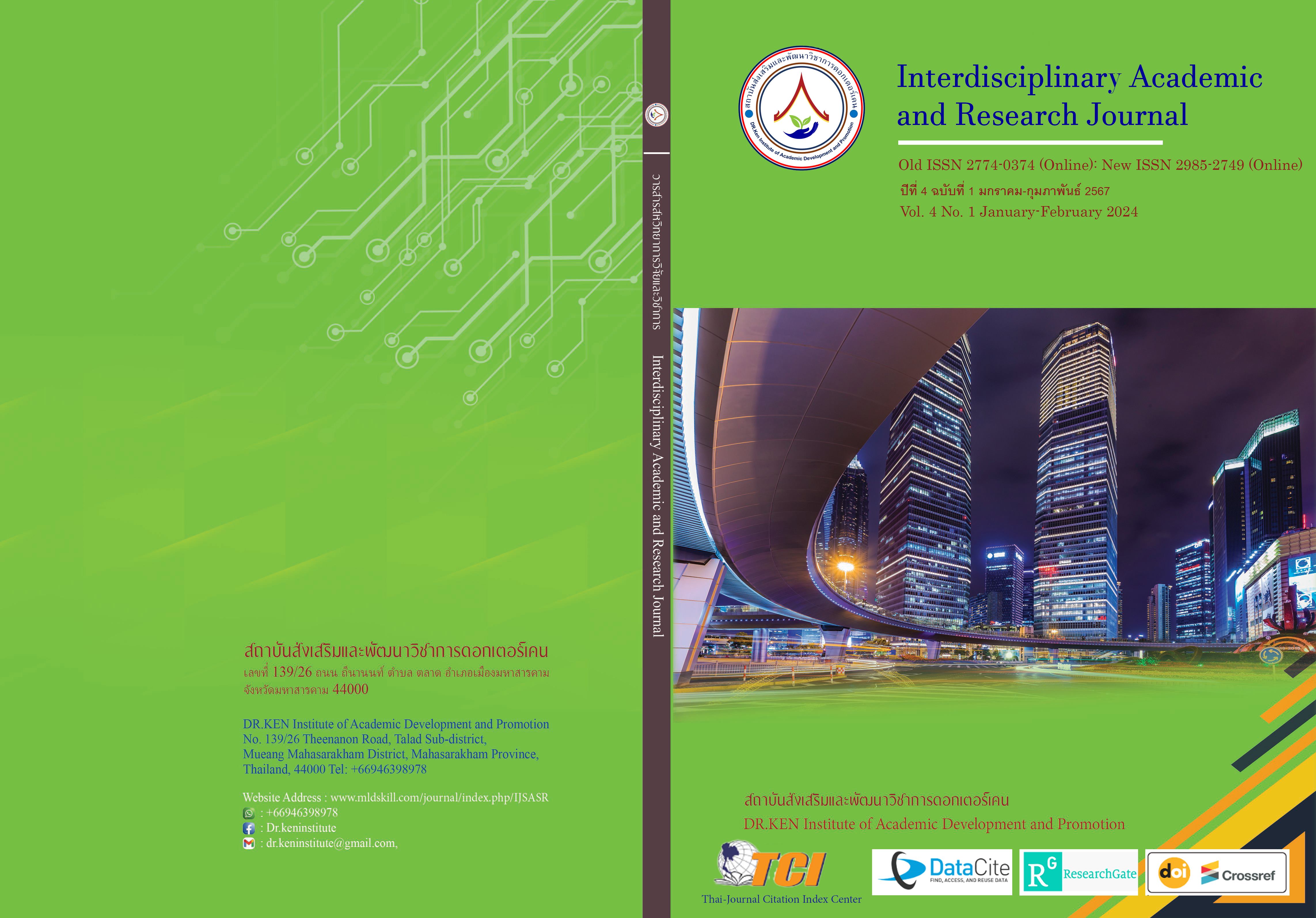Management Effectiveness Model of Rajabhat University Northeastern Region Group
DOI:
https://doi.org/10.60027/iarj.2024.272718Keywords:
Model;, Effectiveness;, Management; , Rajabhat UniversityAbstract
Background and Aims: Rajabhat University also plays an important role in promoting research that focuses on solving problems in its area. This allows for development and innovation that is in line with the needs of the community and society in that area. Rajabhat University plays an important role in creating links between education and industry and is a source of knowledge and skills related to job positions in that area. This makes Rajabhat University play an important role in promoting local and economic development in the area where it is located. Therefore, this research has the objective. (1) To study the management effectiveness level of Rajabhat Universities Northeastern Region. (2) To study factors affecting the management effectiveness of Rajabhat Universities Northeastern Region. (3) To create and confirm a management effectiveness model at Northeastern Rajabhat University.
Methodology: This was divided into 2 phases: Phase 1: The quantitative research sample group is the personnel of Rajabhat University Northeastern Region consisting of 11 provinces, numbering 450 people. Data were collected using questionnaires 5-level estimation scale. Data were analyzed using SEM statistics using the M-Plus program. Phase 2 qualitative research, the target group is administrators’ academics, and support staff of higher education institutions, totaling 15 people. The target group was selected using a specific method (Purposive Sampling). Data was collected using the method of brainstorming (Focus Group Discussion) and analyzed qualitative data content analysis.
Results: (1) the overall management effectiveness of the Rajabhat Universities in the Northeastern region was at a high level. Classified into each aspect, it was found that the highest level was teaching. At a high level, including preserving arts and culture and academic services, and at a moderate level of research. The Factors affecting the management effectiveness of Rajabhat universities in the Northeastern region were found the variables have a direct influence including Leadership factors, motivation factors, communication factors, organizational culture factors, personnel development factors, information technology factors, and teamwork factors. The variables that have an indirect influence include teaching and learning, research, academic services, and arts and culture preservation. These variables can explain 98.50 percent of the variation in management effectiveness of Rajabhat University (EFF; R2 = 0.985). The results of the harmony test found that the "χ" 2/df value was equal to 1.714, which was > 2.00, had a CFI value of 0.995, had a TLI value of 0.981, had an RMSEA value of 0.047, had an SRMR value of 0.043, which the harmony is in good agreement with the empirical data. (3) The management effectiveness model of Rajabhat Universities Northeastern Region which has been evaluated, consists of (3.1) Personnel factors, including 1) Having leaders who have the potential to manage the organization. 2) Motivating personnel to perform their jobs. 3) Teamwork is facilitated. 4) Personnel are knowledgeable ability in that position. 5) Personnel are thoroughly supported in every aspect, especially the infrastructure. (3.2) Organizational factors, include 1) Providing modern technology to support education in the digital age. 2) Having a quality communication network system. 3) Creating an organizational culture that creates an appropriate atmosphere for working. 4) It has developed into a digital organization. 5) It is an organization that can adapt to changing environments. (3.3) Management system factors include 1) Supporting more funds for personnel development. 2) Having appropriate budget management. 3) Managing materials and equipment to be ready for use. 4) Having safety in operations. 5) Proper welfare is provided to personnel.
Conclusion: The study found that Rajabhat universities in the northeastern region of Thailand have high efficiency in overall management, especially in teaching, preserving art and culture, and academic services Identified factors that influence this effectiveness. Including both direct and indirect variables. Emphasizes the importance of leadership, motivation, communication, organizational culture, and efficient management system Comprehensive models provide actionable insights for optimization focus on leadership qualities Technology support communication network organizational adaptation and careful resource management Statistical validation of the model will enhance its reliability and applicability to optimize management practices in these universities.
References
กองนโยบายและแผน มหาวิทยาลัยราชภัฏกลุ่มภาคตะวันออกเฉียงเหนือ.(2566). แผนยุทธศาสตร์มหาวิทยาลัยราชภัฎ. มหาวิทยาลัยราชภัฏกลุ่มภาคตะวันออกเฉียงเหนือ.
ฉัตรณรงค์ศักดิ์ สุธรรมดี.(2558).แนวทางนโยบายการพัฒนาขีดสมรรถนะบุคลากรสายวิชาการของมหาวิทยาลัยราชภัฏในเขตภาคตะวันออกเฉียงเหนือของประเทศไทย.วิทยานิพนธรัฐประศาสนศาตรดุษฎีบัณฑิต.คณะรัฐศาสตร์และรัฐประศาสนศาสตร์.มหาวิทยาลัยราชภัฏมหาสารคาม.
ชูศรี วงศ์รัตนะ. (2560). เทคนิคการใช้สถิติเพื่อการวิจัย. พิมพ์ครั้งที่ 13. กรุงเทพฯ : อมรการพิมพ์.
นิรัช สุดสังข์. (2559). ระเบียบวิธีวิจัยทางการออกแบบ. กรุงเทพฯ:โอเอสพริ้นติ้งเฮาส์.
ปราณี สาไพรวัน. (2558). ปัจจัยทางการบริหารที่ส่งผลต่อประสิทธิผลองค์การของสำนักงานเขตพื้นที่การศึกษาประถมศึกษาสกลนคร เขต 2. วิทยานิพนธ์ครุศาสตรมหาบัณฑิต:มหาวิทยาลัยราชภัฏสกลนคร.
สรคุปต์ บุญเกษม, สันติศักดิ์ กองสุทธิ์ใจ, และวินัย รังสินันท์.(2560). ปัจจัยการบริหารจัดการที่ส่งผลต่อประสิทธิผลโรงเรียนขนาดเล็ก ในเขตพื้นที่การศึกษาประถมศึกษาจังหวัดนครสวรรค์. Humanities and Social Sciences Journal of Pibulsongkram Rajabhat University, 11(1), 217–230. Retrieved from https://so01.tci-thaijo.org/index.php/GraduatePSRU/article/view/79721
สำนักงานคณะกรรมการพัฒนาระบบราชการ. (2556). คู่มือเทคนิคและวิธีการบริหารจัดการสมัยใหม่ตามแนวทางการบริหารกิจการบ้านเมืองที่ดี. กรุงเทพฯ: สำนักงานคณะกรรมการพัฒนาระบบราชการ.
Comrey, A.L., & Lee, H.B. (1992). A First Course in Factor Analysis. 2nd edition. Hillsdale, NJ: Lawrence Erlbaum.
Hair, J., &et al. (2010). Multivariate data analysis. 7th edition. Upper Saddle River, New Jersey: Pearson Education International.
Likert, R. (1967). The Method of Constructing and Attitude Scale, Reading in Attitude Theory and Measurement. P.90-95. Fishbeic, Matin, Ed. New York: Wiley & Son
Downloads
Published
How to Cite
Issue
Section
License
Copyright (c) 2024 Thanikarn Srichan, Saovalak Kosonkittiumporn, Pakdee Phosing

This work is licensed under a Creative Commons Attribution-NonCommercial-NoDerivatives 4.0 International License.
Copyright on any article in the Interdisciplinary Academic and Research Journal is retained by the author(s) under the under the Creative Commons Attribution-NonCommercial-NoDerivatives 4.0 International License. Permission to use text, content, images, etc. of publication. Any user to read, download, copy, distribute, print, search, or link to the full texts of articles, crawl them for indexing, pass them as data to software, or use them for any other lawful purpose. But do not use it for commercial use or with the intent to benefit any business.
















.png)


